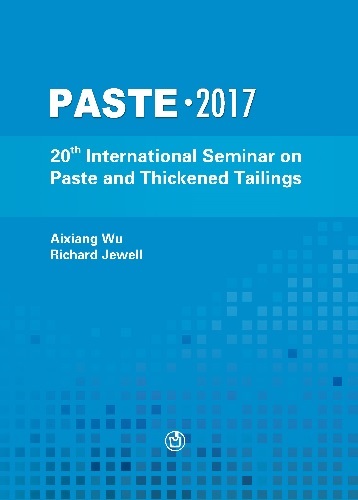Avoiding large tailings dams without going underground-Robinsky’s thickened tailings concept

|
Authors: Fitton, TG |
DOI https://doi.org/10.36487/ACG_rep/1752_27_Fitton
Cite As:
Fitton, TG 2017, 'Avoiding large tailings dams without going underground-Robinsky’s thickened tailings concept', in A Wu & R Jewell (eds), Paste 2017: Proceedings of the 20th International Seminar on Paste and Thickened Tailings, University of Science and Technology Beijing, Beijing, pp. 243-249, https://doi.org/10.36487/ACG_rep/1752_27_Fitton
Abstract:
With the recent high profile failures of the Samarco and Mount Polley tailings dams, governments, environmental groups and mining companies have been looking to alternative methods of tailings storage that are not so reliant on the integrity of large embankment structures. Underground backfill of tailings is an attractive option at first glance, but unfortunately only a partial solution at the best of times; a typical underground mine can only contain a portion of the tailings whilst mining operations are ongoing, whilst a typical open-cut mine has no underground workings to fill. Dry stacking of filtered tailings is another attractive option, but it is relatively expensive in most situations. It is also still developing as a technology, with few large scale operations currently in service. Eli Robinsky’s concept for the surface deposition of thickened tailings is a proven technology with dozens of examples of successful implementation around the world. It is asserted that Robinsky’s thickened tailings concept has been unfairly ignored or dismissed in some parts of the world, resulting in the ongoing construction of many large tailings dams, all of which increase the risk of another major tailings dam failure occurring in future. This paper describes Eli Robinsky’s concepts of Central Thickened Discharge and Down Valley Discharge, and presents some examples that demonstrate how these tailings storage concepts have been successfully applied in dozens of mines around the world. Some indication of the relative disposal cost per tonne for a number of alternative tailings disposal techniques is also presented.
References:
Fitton, T.G. 2007, ‘Tailings beach slope prediction ‘, PhD thesis, RMIT University.
Fitton, T.G. and Roshdieh, A. 2012, ‘The impact of slurry rheology on tailings transport and disposal options-Four case studies’, Paper Presented at IIR Slurry Pipelines Conference 2012.
Fitton, T.G. 2013, ‘Deconstructing dewatering’, International Mining, June 2013 Supplement-Paste Tailings Management, Australian Centre for Geomechanics, Perth.
Fitton, T.G. and Slatter, P.T. 2013, ‘A tailings beach slope model featuring plug flow’, Paper Presented at Paste 2013, Australian Centre for Geomechanics, Perth.
Fitton, T.G. 2014, ‘The accuracy of tailings beach slope predictions’, Paper Presented at Paste 2014, Australian Centre for Geomechanics, Perth.
Fitton, T.G. 2016a, ‘Refining Robinsky-Improving on the Central Thickened Discharge Concept’, Paper Presented at Tailings and Mine Waste 2016.
Fitton, T.G. 2016b, ‘Fitton-Tailings beach slope model incorporating some hydraulic advances’, Paper Presented at Paste 2016, Gecamin, Santiago.
Fourie, A.B. 2012, ‘Perceived and realised benefits of paste and thickened tailings for surface deposition’, Paper Presented to Paste 2012, Australian Centre for Geomechanics, Perth.
Gaete, S. and Bello, F. 2013, ‘Experience with the thickening and discharge of high density tailings: Minera Esperanza’, Paper Presented to Tailings 2013.
Jewell, R.J. 2012, ‘Putting beach slope prediction into perspective’, Journal of The Southern African Institute of Mining and Metallurgy, Vol 112(11), pp. 927-932.
McPhail, G. 2014, ‘Using small scale flumes to determine rheology at low shear rates’, Tailings 2014.
Pirouz, B., Javadi, S., Seddon, K.D., and Williams, M.P.A. 2014, ‘Modified beach slope prediction model for non-segregating thickened tailings’, Paper Presented at Paste 2014, Australian Centre for Geomechanics, Perth.
Quelopana, H. 2015, ‘Tailings Beach Slope Forecasting: What does the data reveal?’, Paper Presented to Tailings 2015.
Robinsky, E.I. 1975, ‘Thickened discharge-A new approach to tailings disposal’, CIM Bulletin, vol. 68, pp. 47-53.
Simms, P., Williams, M.P.A., Fitton, T.G. and McPhail, G. 2011, ‘Beaching angles and evolution of stack geometry for thickened tailings: A review’, Paste 2011, Australian Centre for Geomechanics, Perth.
Williams, M.P.A., Seddon, K.D, and Fitton, T.G. 2008, ‘Surface Disposal of Paste and Thickened Tailings-a brief history and current confronting issues’, Paper Presented to Paste 2008, Australian Centre for Geomechanics, Perth.
Wu, A.X. 2016, ‘Paste and Thickened Tailings operations and research in China’, Australian Centre for Geomechanics.
© Copyright 2025, Australian Centre for Geomechanics (ACG), The University of Western Australia. All rights reserved.
View copyright/legal information
Please direct any queries or error reports to repository-acg@uwa.edu.au
View copyright/legal information
Please direct any queries or error reports to repository-acg@uwa.edu.au